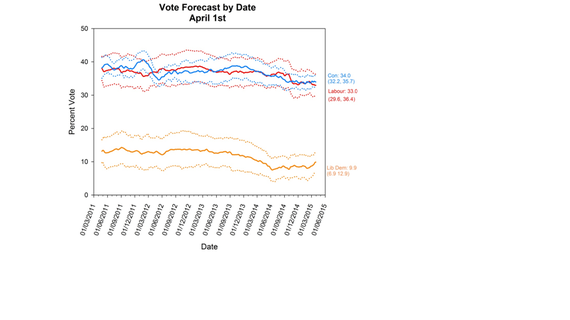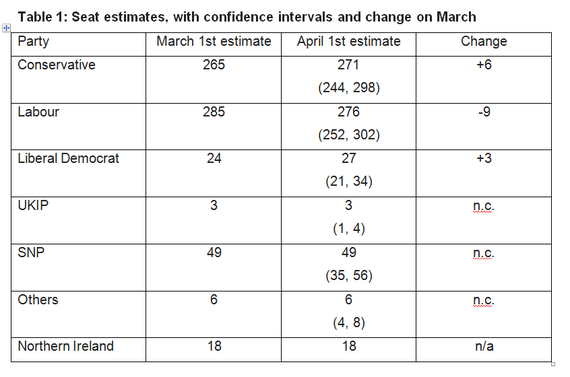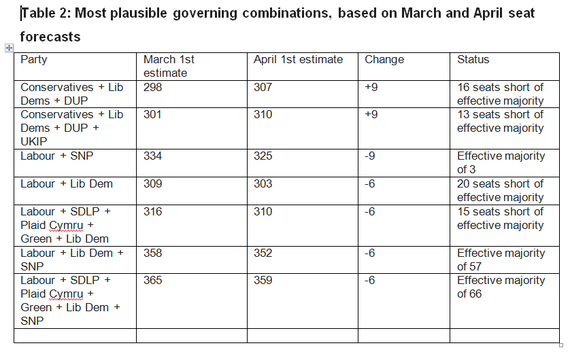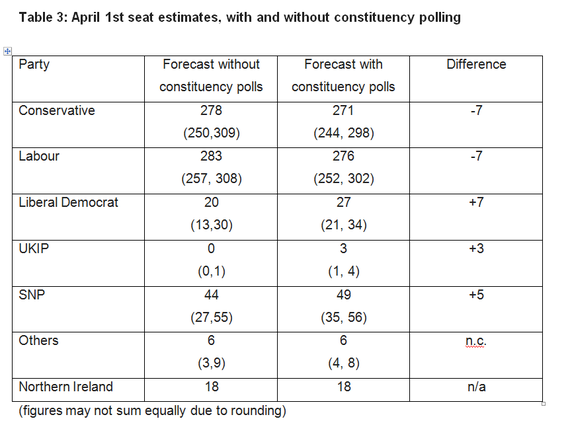Last month we introduced the Polling Observatory seat forecasting model. At the time, Labour was marginally ahead in the polls - but there was little to separate them and the Conservatives. Since then, the Conservatives have gained slightly in the polls - and now at 32.7% (as of March 31st), are exactly even with Labour, which also is at 32.7%, in the popular vote.
Based on these current estimates of support for the parties, our vote forecast suggests a narrow Conservative vote lead in an election which remains too close to call. We forecast the Conservatives to win 34.0% of the vote, up 0.3 points on last month, and enough to give them a slim lead over Labour. Labour are not expected to recover much more than they already have done this month, so we now estimate they will win 33.0% on May 7th. The stabilisation in Liberal Democrat support has helped their prospects somewhat, and our forecast suggests they will win 9.9%, up over a percentage point on last month.
In line with current polling, our updated seat estimates predict an ever tightening race without any fundamental shift in the overall balance (Table 1). Labour decline by nine seats from 285 to 276, while the Conservatives advance by six seats (to 271) and the Liberal Democrats by three (to 27). This gives Labour only a five seat lead.
The shift in our projected seat totals away from Labour and towards the coalition parties does nothing to make post-election arithmetic any simpler. This is clear in Table 2. The likeliest Conservative-led combinations - with the Liberal Democrats, the DUP and UKIP - still fall well short of the 323 votes needed to be sure of winning a confidence vote (this is lower than the theoretical 325 votes for a majority as Sinn Fein's three MPs do not take their seats). Our projected numbers would not leave the Conservatives with many options for forming a government, unless Nicola Sturgeon's alleged interest in a further period of Conservative rule proved to be more than loose talk in a private meeting.
The vehement SNP reaction to the Sturgeon leak confirms that they will be much more comfortable enabling a Labour government than a Conservative one - and with the Scottish nationalists on course for nearly fifty seats, this fact alone currently gives Labour a strong advantage in post-election negotiations. However, the decline in the projected number of Labour seats means it will be risky for Labour to rely on the SNP alone - a Labour-SNP arrangement would command exactly half of the votes in the Commons, and so could only succeed if both parties achieved perfect party discipline (highly unlikely given the differences between the parties, and the behaviour of MPs in recent Parliaments). As such, our current central projection points to a government supported by multiple parties. The Liberal Democrats will have the most votes to supply, but Labour's weak position in the Commons would make it prudent to also seek arrangements with the Northern Irish SDLP, Plaid Cymru and the Greens (the latter two parties have already been co-operating with the SNP on possible post-election positions). In 2010, the idea of a "rainbow coalition" of the left encompassing all these parties was briefly considered by Gordon Brown's advisers, but then rejected as too unwieldy and unstable. As the 2015 election approaches, a similar messy and fissile alliance of parties (more or less) opposed to Conservative government looks, for now, to be the likeliest outcome.
Post-script: A note on uncertainty and constituency polling
This election has been characterised by a proliferation of forecasting models, offered up by an array of academics, media and poll-watchers. These reflect the substantial increase in the amount of information that we now have about public opinion - with a large volume of polls, Lord Ashcroft's constituency polls, and surveys such as the British Election Study. This proliferation of polling and forecasting is in general a good thing - it provides voters and pundits alike with more information about the state of the race and the likeliest possible outcomes. However, with polls and forecasts alike it is essential to pay attention not only to headline numbers, but to how they are derived and to the uncertainty in what they say. The decisions forecasters make, and the assumptions they use, are important to report and examine, just as they are with polls. Forecasting has a role to play in assisting our understanding of election campaigns, but it is important that those reporting on and discussing forecasts do not treat them as black boxes or crystal balls - forecasters are not mystics or savants, but analysts trying to make the best estimate they can from the limited data available - an estimate which can often be highly uncertain, and limited by the assumptions the forecasting model makes, and the factors which can be measured and entered in to it.
One new factor in the 2015 is the proliferation of constituency polls. How do these affect our election forecast? To answer this question, we estimated a version of our seat forecast that excluded the information we have from around 150 constituency polls carried out by Lord Ashcroft (and the by-elections in Clacton and Rochester and Strood). This helps reveal the importance of constituency-level information for our estimates of the parliamentary arithmetic - and how much impact this new and relatively untested source of information has on our view of the likely election result.
As Table 3 indicates, the main beneficiaries from constituency polling are the smaller parties. If these are not included, our seat forecast for both the Conservatives and Labour increases by 7 seats (to 278 and 283 seats respectively). So both big parties gain, but there is no change in their relative positions - they remain deadlocked if we look at national polling alone. In contrast, the Liberal Democrats lose 7 seats - reflecting their traditional local strengths, which have been picked up in many Ashcroft polls. For UKIP, our forecast is reduced from 3 to 0 seats, reflecting the low base of support from 2010 that the party has to build from - even a 10 per cent rise in national polls does not on its own translate to seat gains. Our forecast for the SNP is five seats lower at 44 if constituency polling is excluded, reflecting the fact that Ashcroft's polls in Scottish seats have shown the SNP doing even better in the seats where Labour is strongest, enabling them to overhaul formidable Labour majorities and take seats which would not fall based on the national poll numbers.
Robert Ford, Will Jennings, Mark Pickup and Christopher Wlezien



